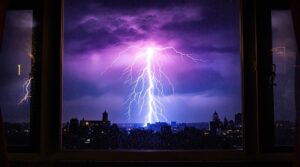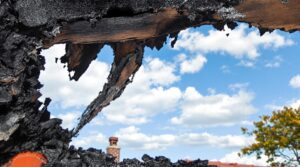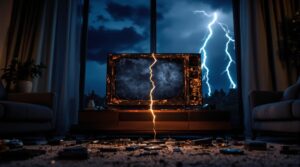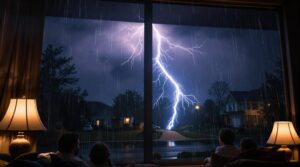Metal roofs benefit from extensive lightning protection systems that provide a safe path for lightning to follow to the ground, reducing the risk of damage, fire, and injury. Building height, size, and location influence lightning risk, with metal roofs not inherently attracting lightning more than other materials. A thorough system, including air terminals and grounding wires, must be installed and inspected regularly for peak performance. Further consideration of system components and installation guidelines is essential for effective protection.
Key Takeaways
- Metal roofs don't inherently attract lightning; height, location, and surface area determine strike probability.
- A thorough Lightning Protection System (LPS) provides a safe path for lightning to the ground.
- Regular inspections and maintenance ensure system effectiveness and maintain warranty coverage.
- Air terminals should be installed at roof corners and intervals not exceeding 20 feet.
- Grounding is necessary for effective lightning strike mitigation, utilizing non-corrosive materials like aluminum or copper.
Factors Contributing to Lightning Strikes on Metal Roofs
Because the potential for lightning strikes is a considerable concern for buildings with metal roofs, understanding the factors that contribute to strike likelihood is essential. The likelihood of a lightning strike is influenced by several factors, including the building's height, location, and design. Metal roofs on taller buildings or those located in areas with high lightning activity are more susceptible to strikes. Additionally, larger surface areas, such as expansive metal roofs, can increase the probability of lightning attachment. The material of the roof itself, including metal, does not inherently attract lightning more than other roofing materials. However, the roof's height and design considerably influence strike likelihood, emphasizing the importance of integrating lightning protection systems, grounding, and strike termination devices to mitigate the risk of lightning damage.
Protecting Metal Roofs From Lightning Strikes
Metal roofs can be effectively protected from lightning strikes through the installation of extensive lightning protection systems. These systems integrate air terminals, grounding systems, and other components to safely direct the energy from lightning strikes away from the building's structure and occupants.
Key considerations for protecting metal roofs from lightning strikes include:
- Installing air terminals at the highest points of a metal roof to intercept lightning strikes
- Connecting ground wires to air terminals to create a low-resistance path for lightning to follow
- Guaranteeing proper installation of lightning protection systems as outlined by NFPA 780
- Integrating air terminals with grounding sources to dissipate the energy from a strike
- Regularly inspecting and maintaining the lightning protection system to guarantee effectiveness and compliance with safety standards.
Lightning Strike Risk Assessment for Metal Roofs
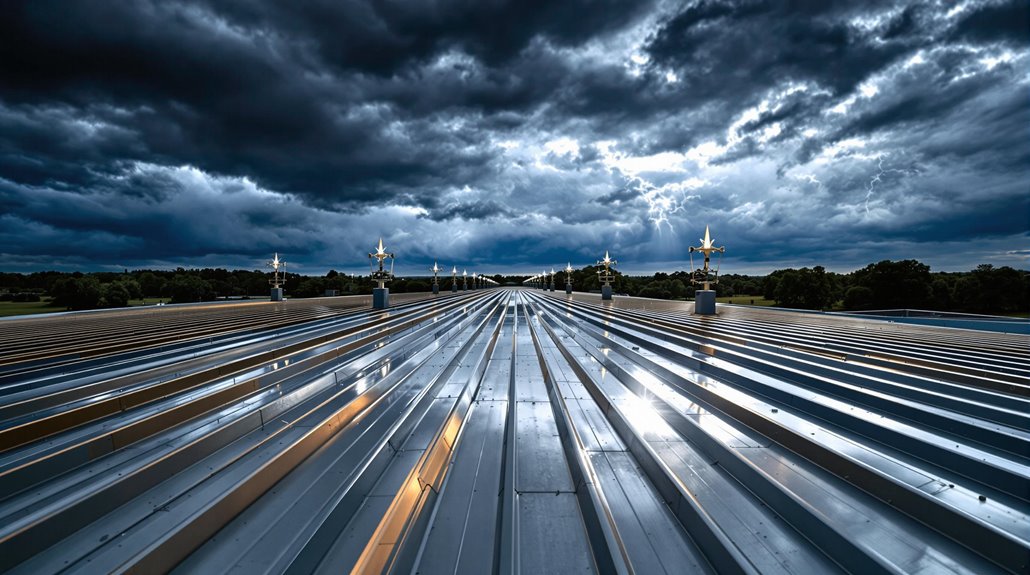
Metal roofs are susceptible to lightning strikes due to various factors, including building height, size, and surrounding topography, which can increase the likelihood of a strike. Evaluating lightning risk is vital for metal roofs, particularly in areas with high flash densities, to determine the necessity of implementing a Lightning Protection System (LPS). A thorough risk evaluation should consider the roof's material properties, installation, and maintenance practices to guarantee effective protection against potential lightning strikes.
Metal Roof Strike Factors
While the material composition of a roof is often mistakenly believed to be a notable factor in attracting lightning strikes, the reality is that lightning is drawn to the highest point on a structure, regardless of whether the roof is made of metal, wood, or other materials. The actual risk factors for lightning strikes on metal roofs are more nuanced.
- Building height and size greatly influence lightning risk
- Geographic location plays an important role, with areas experiencing higher lightning flash density being more susceptible
- Approximately 25 million lightning strikes occur annually in the U.S., as reported by the National Lightning Detection Network (NLDN)
- A thorough Lightning Protection System (LPS) provides a safe path for lightning to reach the ground, protecting the building and occupants
- Adequate grounding is essential for effective lightning protection.
Assessing Lightning Risk
Evaluating the risk of lightning strikes on a building with a metal roof requires an extensive analysis of several key factors. Local lightning flash density, building height, and surrounding topography all greatly influence the likelihood of a strike. The National Lightning Detection Network (NLDN) provides data on lightning occurrences, allowing property owners to gauge risk based on geographic location. A lightning protection system (LPS) may be necessary for buildings in high lightning frequency areas or providing essential services, if exposure exceeds tolerable risk levels. A risk evaluation also considers roofing materials, the presence of flammable materials, and continuity of critical services. Understanding the metal roof's characteristics, including height and surface area, is essential for accurately evaluating its vulnerability to lightning strikes.
Effects of Lightning Strikes on Metal Roofs
Although lightning strikes can pose a significant threat to buildings, a metal roof can play an essential role in mitigating the effects of such an event when properly grounded. A properly grounded metal roof can effectively dissipate lightning energy, reducing the risk of heat buildup and subsequent fire damage. Key benefits of metal roofs in lightning strikes include:
- Non-combustible materials prevent ignition from lightning strikes
- Reduced risk of heat buildup and fire damage when properly grounded
- Sensitive electronic devices may still be at risk of damage from lightning surges
- Properly installed lightning protection systems distribute energy evenly, minimizing damage
- Research indicates metal roofs may reduce fire damage potential compared to traditional materials during lightning strikes.
Lightning Protection System Installation for Metal Roofs

Metal roofs can effectively mitigate the effects of lightning strikes when properly grounded, but the installation of a Lightning Protection System (LPS) is necessary to guarantee ideal protection. To ascertain secure attachment without damaging the roof's integrity, S-5! clamps and brackets are recommended for mounting LPS on metal roofs. Proper installation of air terminals, positioned at roof corners and intervals not exceeding 20 feet, is essential for effective lightning interception and compliance with NFPA 780 standards. Conductors should be placed beneath the roof deck during construction to maintain aesthetic appeal and secure safety. Regular inspections are vital to confirm continued effectiveness and address potential damage or disconnections. A well-designed and installed LPS provides reliable protection for metal roofs against lightning strikes.
Standing Seam Roofing and Lightning Protection
Structural integrity and safety converge as primary concerns when integrating lightning protection systems with standing seam metal roofs. To address these concerns, S-5! clamps provide a secure attachment for lightning protection systems without damaging the roof surface. The following benefits highlight the importance of compatible attachments:
- Damage-free installation on standing seam roof profiles
- Versatility in design for various metal roof profiles
- Preserves roof integrity during lightning protection system installation
- Guarantees effective energy dissipation and minimizes fire risk
- Maintains aesthetic and functional qualities of standing seam roofing while enhancing safety with copper and other materials. By utilizing S-5! clamps, copper lightning protection systems can be installed on standing seam roofs, enhancing the safety and structural integrity of the building.
Exposed-Fastened and Corrugated Roofing Lightning Protection
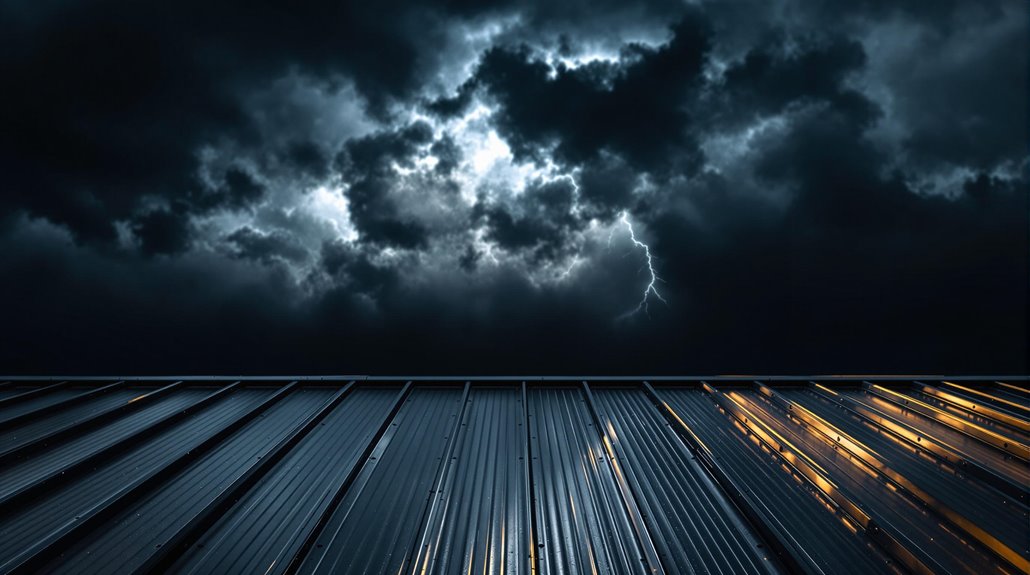
When it comes to exposed-fastened and corrugated metal roofing, guaranteeing reliable lightning protection is vital for safeguarding both the structure and its occupants. S-5! brackets provide a secure attachment for lightning protection components while maintaining the integrity of the roofing material. These brackets feature factory-applied weather-proofing seals and gaskets, guaranteeing durability and performance of the lightning protection system. Engineered for easy installation on various metal roof profiles, S-5! products prevent surface abrasion and guarantee conductors remain securely attached. Utilizing non-corrosive materials, S-5! supports the longevity and effectiveness of the LPS. Proper installation is vital to minimize the risk of detachment. For exposed-fastened and corrugated metal roofs, incorporating S-5! brackets is key to reliable lightning protection and structural integrity, guaranteeing the safety of occupants and the roof system itself.
Warranty and Maintenance of Lightning Protection Systems
The long-term reliability of a lightning protection system on a metal roof is heavily dependent on both warranty coverage and system maintenance requirements. Industry-leading manufacturers, such as S-5!, provide lifetime warranties for their products, guaranteeing performance and durability. Regular inspections and maintenance are also essential to guarantee continued compliance with safety standards and maximum system functionality.
System Maintenance Requirements
All lightning protection systems require routine inspections and maintenance to guarantee ongoing compliance with safety standards and peak performance. This guarantees the system remains effective in protecting metal roofs from lightning strikes while meeting building codes. Industry-leading manufacturers like S-5! design their products to be durable and long-lasting, minimizing the need for maintenance. Key maintenance considerations include:
- Regular inspections to confirm system integrity and effectiveness
- Post-work inspections after roofing adjustments or repairs
- Checking for loose or damaged components
- Confirming all connections are secure and not compromised
- Reviewing installation quality to prevent potential issues
Warranty Coverage Details
Beyond routine inspections and maintenance, an equally important consideration for metal roof owners is the warranty coverage of their chosen lightning protection system. S-5! products offer industry-leading lifetime warranties, guaranteeing peace of mind for building owners. The following table highlights key warranty features:
| Warranty Feature | S-5! Advantage |
|---|---|
| Manufacturer-Approved | Does not void existing roof warranties |
| Industry-Leading Lifetime Warranty | Guarantees long-term protection and reliability |
| Minimal Maintenance Required | Designed to last the lifespan of the roof |
S-5! products are engineered to provide secure attachment of lightning protection systems without compromising metal roof integrity, guaranteeing warranty coverage remains intact. Regular inspections and maintenance are essential to maintaining warranty conditions. By choosing S-5! products, metal roof owners can trust their lightning protection system is backed by a thorough warranty.
Importance of Regular Inspections for Lightning Protection Systems
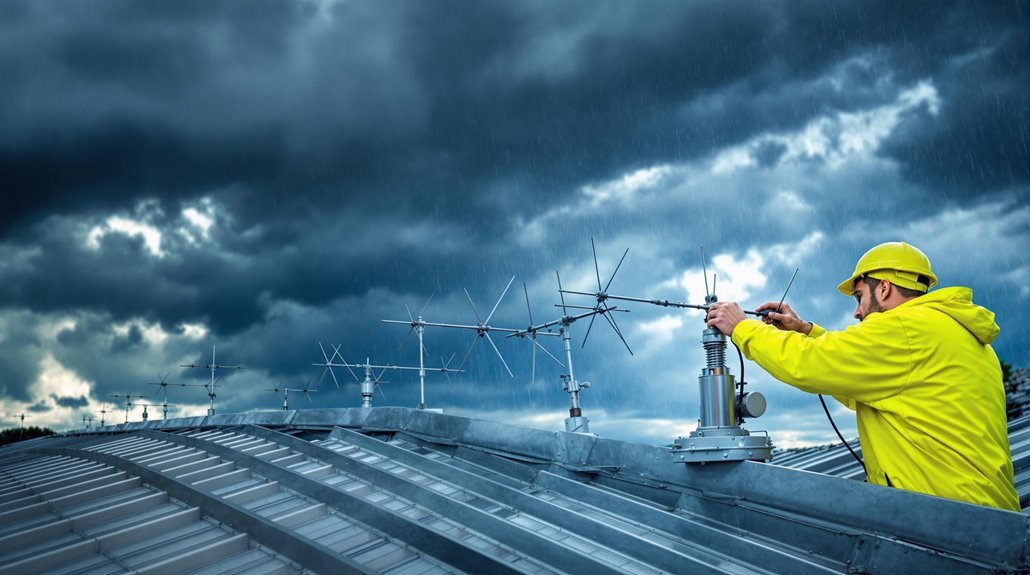
Regular inspections are a critical component of an all-encompassing lightning protection system (LPS) for metal roofs, as they verify that all air terminals, conductors, and grounding systems are properly connected and functioning as intended. Certified professionals should conduct post-installation inspections to identify potential issues, such as loose connections or corrosion.
- Inspections help prevent costly repairs and protect sensitive electronic equipment from lightning surges
- Maintenance checks should be conducted at least annually and after severe weather events
- Inspections guarantee compliance with NFPA 780 standards and local codes governing LPS
- Documenting inspection findings and maintenance actions is essential for maintaining liability coverage
- Regular inspections can notably reduce the risk of lightning damage, which can cause nearly a billion dollars in annual losses in the U.S.
Ensuring Compatibility of Lightning Protection Systems With Metal Roof Designs
When specifying and installing a lightning protection system (LPS) on a metal roof, validating compatibility between the two is paramount to guarantee the effectiveness and longevity of both the LPS and the metal roofing system. S-5! clamps and brackets securely attach LPS without damaging the roof surface. NFPA 780 guidelines emphasize air terminals at roof corners and intervals of 20 feet. Utilizing non-corrosive materials like aluminum and copper validates long-term compatibility.
| LPS Component | Compatibility Consideration |
|---|---|
| Air Terminals | Install at roof corners and 20-foot intervals |
| Attachment Hardware | Use S-5! clamps and brackets to prevent roof damage |
| Materials | Choose non-corrosive materials like aluminum or copper |
